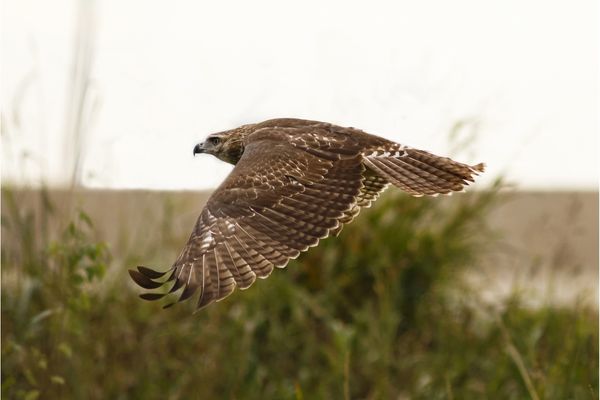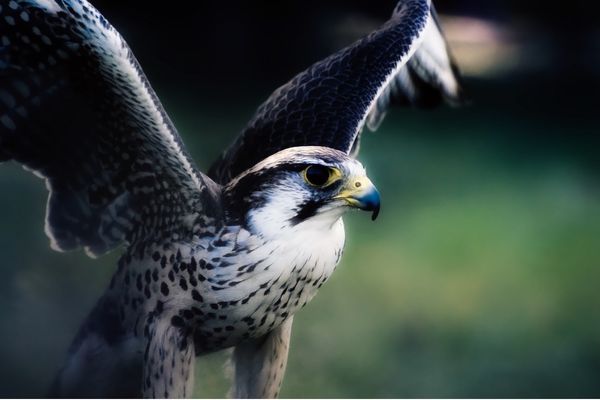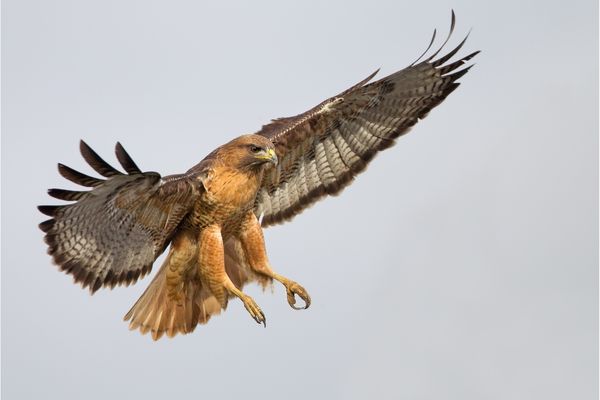All about Birds
A Birdwatcher’s Guide to Cooper’s Hawks and Red-Tailed Hawks
For birdwatchers, a Cooper’s Hawk and a Red-Tailed Hawk can be two of the most interesting and rewarding birds to observe. These two species have very different behaviors, sizes, and habitats, so it’s important for any keen birdwatcher to understand both of them in order to properly identify one from the other
Chicken Hawk vs. Red-Tailed Hawk: How to Tell These Birds Apart?

When it comes to the differences between Cooper’s Hawks and Red-Tailed Hawks, there are a few key points to remember.
The most obvious difference is in size: Cooper’s Hawks tend to be much smaller than Red-Tailed Hawks, with a wingspan of about 18 inches as opposed to 30 or more for the larger Red-Tailed Hawks. Additionally, Cooper’s Hawks have a distinctive chestnut brown back and tail, while the Red-tailed hawk has its namesake reddish brown tail combined with a gray head and breast.
In terms of behavior, Cooper’s Hawks are more likely to be seen in urban areas hunting for small birds like sparrows, while Red-tailed Hawks are more at home soaring in open areas. Additionally, it’s important to note that Cooper’s Hawks tend to be fairly shy and elusive birds, while Red-Tailed Hawks can sometimes be quite bold or even aggressive if they feel threatened.
Habitat: Where Do These Birds Live?
Cooper’s Hawks and Red-Tailed Hawks both prefer to remain near wooded areas, although the Cooper’s Hawks will often move into more urban settings looking for food.
Both species tend to avoid open grasslands or prairies in favor of denser forests with plenty of cover. They are both considered to be permanent residents in their respective ranges, although some individuals will migrate south during the winter months.
When it comes to nesting habits, Cooper’s Hawks tend to build their nests high up in trees, usually at least 50 feet above the ground. Red-Tailed Hawks, on the other hand, prefer to nest on cliffs or tall structures. Additionally, Cooper’s Hawks will lay anywhere from two to six eggs per nest while Red-Tailed hawks only lay one or two eggs in a single clutch.
Feeding Habits: What Do These Birds Eat?
Cooper’s Hawks are primarily carnivorous birds that feed on small mammals, reptiles, and birds. They are also adept hunters, using their sharp talons and beaks to take down prey with ease. Red-tailed Hawks are more opportunistic feeders, hunting for small mammals and carrion while also scavenging on carcasses discarded by other animals.
What’s the difference between Cooper’s Hawk and Red-tailed Hawk?

Both birds are medium-sized hawks, but there are distinct differences between them that can easily be noticed by birders and novice viewers alike.
Cooper’s Hawk (Accipiter cooperii) is native to North America and is known for its aggression in hunting prey. It has a slightly larger size than the red-tailed hawk and has a noticeable dark cap on its head. Its wings are usually pointed and slender with broad, rounded tips. The Cooper’s hawk also has good vision and agility that make it an excellent hunter.
The red-tailed hawk (Buteo jamaicensis) is the most common and widespread species of hawks in North America. It has a distinct reddish-brown tail and its wings are rounded, with the outer edges of the feathers being slightly darker.
The red-tailed hawk is often seen soaring high above open fields, using thermals to help it stay aloft. Red-tailed hawks also have excellent vision, but they tend to hunt by waiting and watching more than by actively pursuing their prey.
The diet of the two birds also differs – Cooper’s hawks are more likely to hunt and eat small mammals, while red-tailed hawks tend to stick to a diet of mostly rodents and small birds. Both species may occasionally consume reptiles, amphibians and invertebrates, but they have a preference for different prey.
The calls of the two birds are also quite distinct. Cooper’s hawks have a loud, sharp whistle that is often heard when they’re perched in trees or flying through the air. Red-tailed hawks have a much more subdued call that is usually a low honk or bark.
Overall, the differences between Cooper’s Hawk and Red-tailed Hawks are quite clear. From the size of their bodies to their diet, these two species are easily recognizable by even novice viewers.
With a bit of practice and observation, anyone can tell them apart. So next time you’re out birdwatching, take some time to observe both species and learn more about their differences. You may be surprised by what you find!
How can chickens be protected from chicken hawks & other birds of prey?

Chickens are a popular choice for many homesteads, small farms, and backyard flocks. Unfortunately, they are also prey to predators like hawks and other birds of prey. If you have chickens in your yard or on your farm, it is important to take steps to protect them from raptors.
One of the most common birds of prey that can threaten chickens is the Cooper’s Hawk (Accipiter cooperii). Also known as a “chicken hawk,” this raptor is found all over North America and specializes in hunting small-to-medium sized birds like quail, doves, crows, and—you guessed it—chickens.
The Red-tailed Hawk (Buteo jamaicensis) is another large bird of prey that can take chickens, but it tends to focus more on small rodents and other ground-dwelling animals.
The good news is there are steps you can take to reduce the risk of predators like Cooper’s Hawks and Red-tailed Hawks taking your chickens.
First, you can minimize the amount of open space in your yard or on your farm. Cooper’s Hawks and other raptors rely on surprise when hunting; if there are a lot of trees, bushes, and other sources of cover around, it makes it harder for them to get a good approach angle on their target.
Second, you can try to keep the birds in areas that are well-lit and visible. If you have chickens free-ranging or in an open pen, make sure they’re not in places where they could be easily surprised by a raptor.
Third, you can use protective netting over the area where your chickens are kept. This will act as a physical barrier to keep out any hawks or other birds of prey that come close. The netting should be firmly attached and high enough off the ground so they won’t be able to get through it.
Which is more common Cooper’s hawk or Red-tailed hawk?
The Red-tailed hawk is more common than Cooper’s hawk. It is commonly seen soaring in the open sky or perched on telephone poles throughout much of North America and can be found in a wide variety of habitats including farmland, desert, forests, mountains, coasts, and urban areas. The Red-tailed hawk has an impressive wingspan that reaches up to four feet.
The Cooper’s hawk, on the other hand, is less common and has a shorter wingspan that reaches up to three feet in size. It is found throughout North America and prefers wooded areas for hunting and nesting where it can find small animals like mice, voles, squirrels, and birds. Although they are less common, they are still seen frequently in backyards and parks.
Which is bigger, Cooper’s hawk or Red-tailed hawk?

When most people think of raptors, they think of the majestic Red-tailed hawk. It is one of the most prevalent species of hawks in North America, and it can be seen soaring on thermal winds or perched atop a telephone pole. But there is another hawk that often flies under the radar: Cooper’s hawk.
Although they look similar to the Red-tailed hawk, Cooper’s hawks are considerably smaller. In fact, they are about one-third of the size of their larger cousin – making them more comparable in size to a crow than a hawk.
When comparing the two birds side by side, it is easy to see why people might confuse them. Both have similar coloring – reddish brown above and light-colored underneath – and a hooked beak. However, Cooper’s hawk has a larger head in relation to its body, as well as a shorter tail than the Red-tailed hawk.
Both of these raptors hunt by surprise. The Red-tailed hawk hunts from high above, using its exceptional eyesight to spot prey on the ground below. Once it has seen a potential meal, it dives down and grabs it with its strong talons. The Cooper’s hawk does not hunt from high above like the Red-tailed hawk but instead prefers to remain closer to the ground or trees.
It uses it’s acute hearing to search for prey, often hiding in dense vegetation or stalking it on the ground. When it is close enough, it will pounce and grab its prey with sharp talons.
Cooper’s hawks are also more aggressive than Red-tailed hawks when it comes to defending their nests. They will dive bomb potential predators and even attack them with their talons to drive them away. They are also more likely to nest in dense foliage, where they can be better concealed from potential predators.
When it comes to diet, the two hawks have very different tastes. The Red-tailed hawk prefers larger prey such as rabbits, squirrels, and other mammals. The Cooper’s hawk, on the other hand, prefers to prey on smaller animals such as small mammals, reptiles, and birds.
So when it comes down to size, the Red-tailed hawk is much larger than its cousin the Cooper’s hawk. They differ greatly in hunting strategies and diet preferences – but both are incredible predators that are a joy to watch in the wild. In conclusion, it is clear that although they may look similar at first glance, the Red-tailed hawk and Cooper’s hawk have many differences that set them apart.
Will Cooper’s Hawks Eat Chickens?
In some cases, yes. Cooper’s Hawks are birds of prey and so they occasionally hunt wild chickens, domestic barnyard chickens, especially if they are unavailable to other food sources. That being said, a well-fed Cooper’s Hawk is unlikely to hunt poultry for its meals, as their hunting abilities usually center around small animals or birds like sparrows and quail.
Moreover, the raptors have been known to leave larger prey unharmed despite catching them in order to conserve energy while hunting. As a result it can be said that Cooper’s Hawks pose little threat to the average chicken coop unless the environment is one of scarcity; then these majestic birds may take their chances against your feathered friends.
Will Red-tailed Hawks Eat Chickens?

Red-tailed Hawks are raptors that often live in open areas near fields, rivers and coasts where they can hunt for food. While their diet is mainly comprised of small mammals, birds and reptiles, these predators have also been known to take chickens from the coops of unsuspecting farmers.
Whether these birds will actually hunt chickens depends on their availability in a particular area; if rodents, snakes and other creatures are ample in the hawk’s territory they may not bother with a chicken coop at all. Nevertheless, it pays to be vigilant when it comes to protecting one’s chickens from such predators.
Building strong fences around your flock as well as checking regularly for signs of disturbance can go a long way towards keeping your chickens safe.
Conclusion
Cooper’s Hawks and Red-tailed Hawks are two of the most iconic birds of prey in North America. Both species have similar physical characteristics and behaviors, but they differ in their habitat preferences and hunting techniques. The Cooper’s Hawk is smaller than the Red-tailed Hawk, has a more slender silhouette, likes to hunt smaller prey, and prefers to inhabit deciduous forests.
The Red-tailed Hawk is larger than the Cooper’s Hawk, has a broader body, likes to hunt larger prey, and prefers to inhabit open areas such as fields and grasslands. For bird watchers, knowing the differences between these two birds of prey can make all the difference in their birding experience. With a little knowledge and patience, it’s possible to get close enough to both species to appreciate their beauty and power up close.

